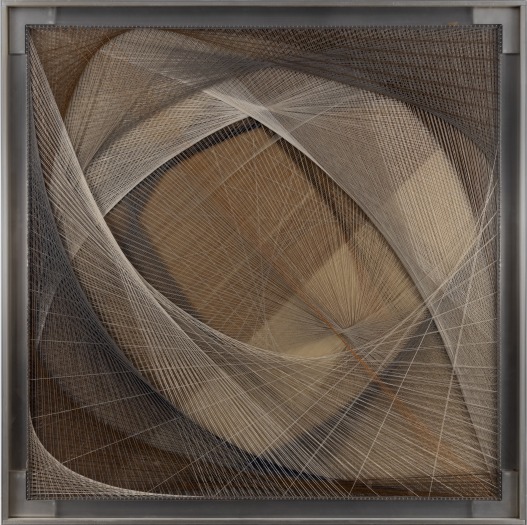SUE FULLER (1914–2006)
The Art Show | Booth D26
November 1-5, 2023
Park Avenue Armory
643 Park Avenue
New York, NY 10065
Balance, motion, suspension and tension form the guiding principles of the work of Sue Fuller, one of the most innovative artists in the field of geometric abstraction in post-war United States. Having studied under Hans Hofmann (1934), Stanley Hayter (1943), and Josef Albers (1944), Fuller was initially recognised as a prominent figure in Hayter’s famous New York print workshop, Atelier 17, where, by the mid-1940s she developed an interest in geometric abstraction. This led her to adopt string as a tool to create three-dimensional compositions in a range of colours, differing scales and varying densities across a delicate, almost invisible framing structure.
During the second half of the 1940s, Fuller became an active figure at the Museum of Modern Art, New York, where she worked as an educator, eventually mounting the exhibition Experiments in Mobile Design in 1947 together with some of her students. Her art soon gained the attention of several major institutions, and in addition to a Guggenheim Fellowship awarded to her in 1949, she was subsequently included in a number of important museum survey exhibitions. These include Abstract Painting and Sculpture in America (MoMA, 1951), Modern Art in the United States (Tate Gallery, 1956), Geometric Abstraction in America (Whitney, 1962) and The Responsive Eye (MoMA, 1965). As a result, her work can be found today in the collection of nearly forty public institutions across the United States.
After she was met with the challenge of displaying and preserving her work in string within a museum context, Fuller became determined to rethink her choice of materials and acquired advanced conservation skills. She benefited from the know-how of her colleagues at MoMA and visited professional fairs of different industrial sectors, applying the lessons to her innovative practice. As a result, her work from the mid 1950s onwards exemplifies an unconventional range of materials including fishing lines, and synthetic surfaces such as Lucite, both of which conserve her compositions’ delicate tension and vivid colour schemes.


